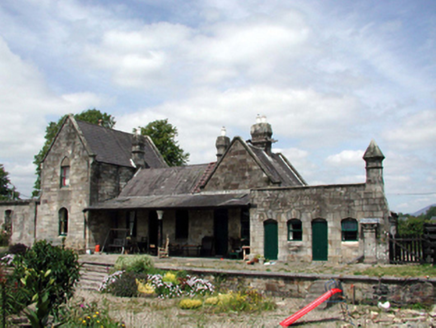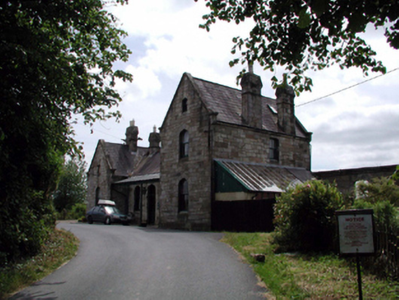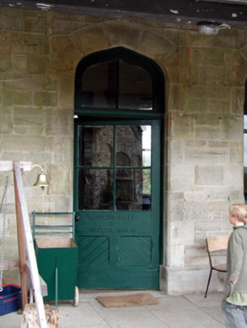Survey Data
Reg No
22809062
Rating
Regional
Categories of Special Interest
Architectural, Historical, Social
Original Use
Railway station
In Use As
House
Date
1870 - 1875
Coordinates
204572, 97826
Date Recorded
25/06/2003
Date Updated
--/--/--
Description
Detached five-bay single- and two-storey Tudor-style railway station with dormer attic, opened 1872, retaining original fenestration comprising three-bay single-storey entrance block with three-bay single-storey lean-to open veranda to front, single-bay single-storey gabled projecting end bay to left, and single-bay two-storey gabled projecting end bay with dormer attic to right extending into single-bay two-storey return to south-west having single-bay single-storey lean-to conservatory to west, two-bay single-storey lean-to open veranda along platform (south) elevation, and four-bay single-storey end block to south-east. Closed, 1967. Now in residential use. Pitched slate roofs (gable-fronted to projecting bays) with clay ridge tiles, snecked Derbyshire grit stone chimney stacks, square rooflights, cut-stone coping to gables, and cast-iron rainwater goods on cut-stone eaves. Lean-to glazed roof to open veranda to entrance (north) front in iron frame on cast-iron pillars. Lean-to slate roof to open veranda to platform (south) elevation on cast-iron column having Corinthian capital. Lean-to glazed roof to conservatory in iron frame. Irregular coursed snecked Derbyshire grit stone walls. Ogee-headed window openings (some square-headed) with cut-stone chamfered sills, and cut-stone voussoirs. 1/1 timber sash windows. Ogee-headed door openings with glazed tongue-and-groove timber panelled doors having raised lettering, and overlights. Road fronted with irregular coursed snecked Derbyshire grit stone screen wall to west having piers including polygonal terminating pier to west with cut-stone finial, shallow segmental-headed openings, and cut-stone coping. Platform along south elevation with random rubble stone retaining wall, cut-stone coping, and landscaped grounds to site of former railway line.
Appraisal
A picturesque Tudor-style railway station of considerable importance for its connection with the introduction of the railway network system to Lismore in the late nineteenth century. Sponsored by the Duke of Devonshire, and constructed in Derbyshire grit stone imported from Chatsworth, the railway station formed an integral component of the development of the Waterford, Dungarvan, and Lismore Railway line. The construction of the building attests to high quality local stone masonry while most of the original fabric remains intact, despite closure in the late twentieth century, and a subsequent change of use. Fronting directly on to the road, the railway station contributes significantly to the quality of the townscape.





